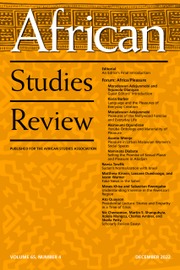As indicated by its subtitle, this book is first and foremost a social history of Cape Coast in modern-day Ghana. Kwaku Nti’s book is an excellent example of what microstudies can achieve: a precise and detailed analysis of societies grounded in their environment. Divided into seven partly chronological, partly thematic chapters, the book covers the period between the early nineteenth century and the 1930s.
The first chapter begins with a rather classical study of the migrations that led to the creation of Cape Coast. It reminds the reader of the long historiography on the topic and provides a useful summary of the different African and European dynamics at play in the early nineteenth century. In a quasi-ethnographic way, the second chapter analyzes the gender dynamics in the patrilineal and matrilineal groups of the coast. It explains the expectations of the various members of Cape Coast society in a moment of reinforced British colonial presence in the mid-nineteenth century. These first two chapters may not be particularly useful for a specialist in the region, but they do a great job of setting the scene in a helpful manner.
The third chapter will be of particular interest to maritime historians. It focuses on the relationship between coastal communities and the members of political. social and martial associations called asafo companies. The author does an excellent job at showing the internal rivalries between different communities and explains particularly well the concepts of “bravery” as well as “communal ownership” in this context. This attention to how individuals and communities saw their world can also be seen in the fourth chapter. This time, the author focuses on art and the influence of different religions on the concepts of “pride” and “liberty.” Without these ideas, it would be impossible to understand the reaction of the people of Cape Coast when confronted with colonial authority. Nti’s history of Cape Coast is based on the inhabitants’ ideas of their world.
The last three chapters deal directly with the colonial period from the point of view of the inhabitants of Cape Coast. The fifth chapter details how the inhabitants of southern Cape Coast used their concept of land and sovereignty against British colonial bills enacted in the late nineteenth century. The sixth chapter shows how southern Gold Coast communities faced the political, economic, cultural, and judicial challenges posed by the British colonizers. It focuses on their reaction to two projects, which would cost Cape Coast its domination over the rest of the southern Gold Coast: the new railway and the transfer of the capital to Accra. Finally, the last chapter analyzes the origins of the conflict before and during the 1932 Legislative Council Elections. Nti retraces the different rivalries between the colonial government and the other political actors of Cape Coast at the start of the 1930s.
Many scholars might have written such a book differently. Is it because Western-trained historians would instead write about global and transnational connections that Nti’s book might seem like an old-fashioned study to a reader based in London in 2025? It might be a question of academic fashion, but it also says something about the way historians write about African societies depending on where they work. So yes, my first impression was that I would have enjoyed a more substantial analysis of Cape Coast’s connections to the rest of West Africa or the Atlantic World, but I was wrong. A micro-study of the southern Gold Coast is incredibly rewarding as it is grounded in studying various primary sources. Nti used mainly ethnolinguistic sources, interviews and colonial archives to write his analysis of Cape Coast. The book was framed around concepts used by the inhabitants of the Coast themselves and not ideas imposed by the current historiography. For all these reasons, it was a pleasure reading Nti’s work.
The book’s title promised the reader a nineteenth- and twentieth-century study, and—it’s a good sign—the reader would like to know more. Why stop in the 1930s? Somehow, the first two chapters did not seem as important as the following ones, and I wasn’t sure why we stopped in 1932 when I read the epilogue. The introduction framed the book in a slightly more promising way.
Maritime history is on the rise again, and this book has all the potential to show how it can be done from the ground in Cape Coast.


